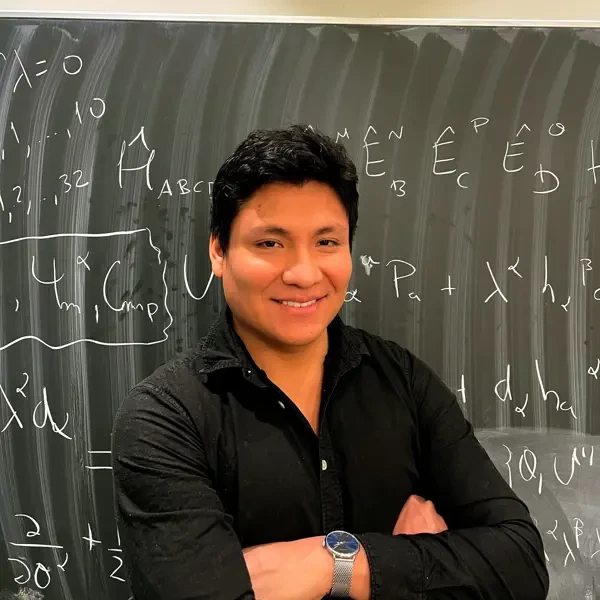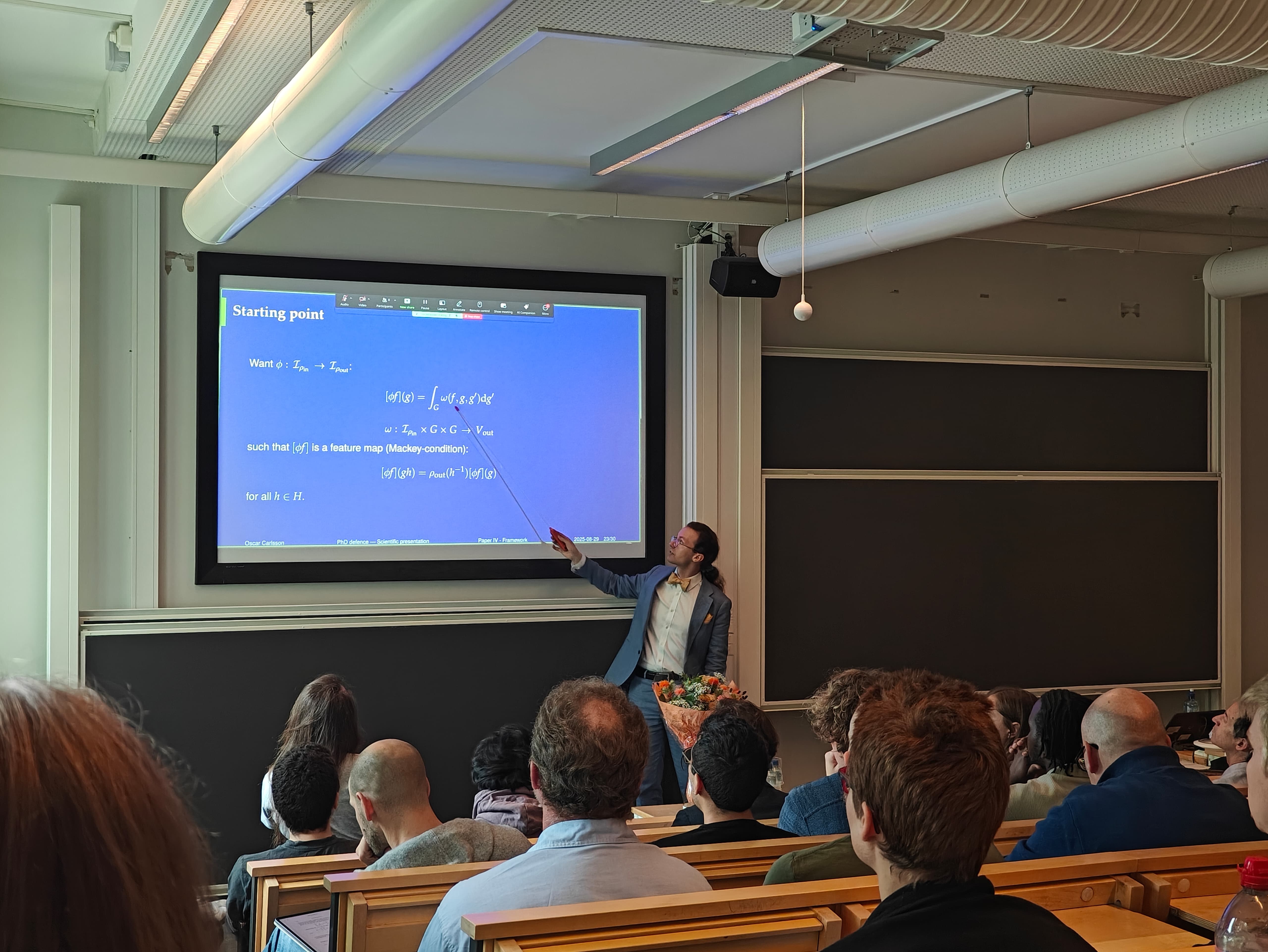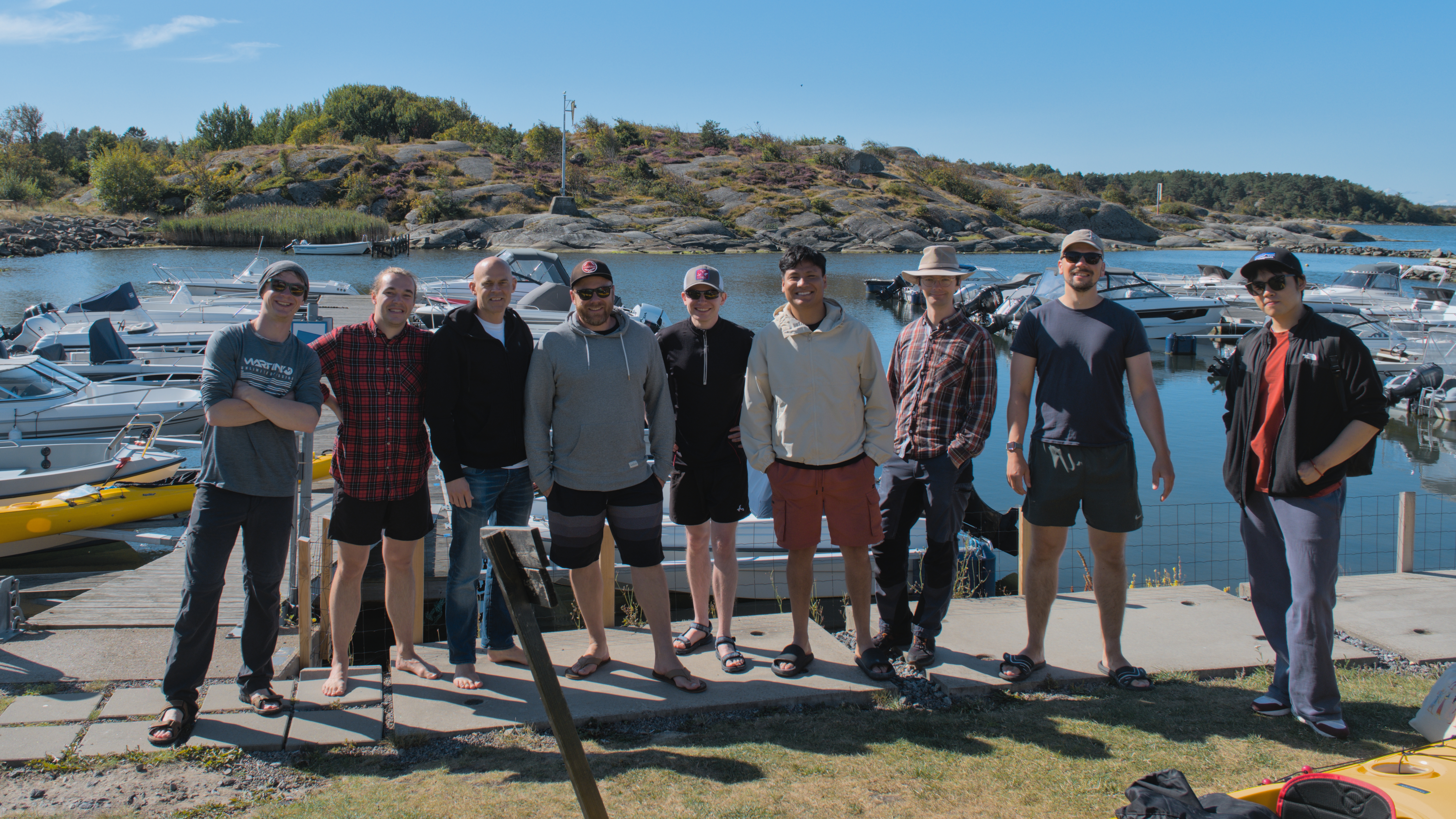Max Guillen
Postdoc

About me
I obtained my PhD in 2019 at ICTP South American Institute for Fundamental Research. In 2020, I joined the Department of Physics and Astronomy at Uppsala University as a postdoctoral researcher. I started a new postdoctoral position in 2024 in the department of Mathematical Sciences, division of Algebra and Geometry at Chalmers University of Technology and the University of Gothenburg.
My main research on AI focuses on mathematical or physics-based formulations of foundational aspects of Deep Learning, e.g:
- Field theory descriptions of finite-width neural networks
- Effective field theory formulations of neural scaling laws in LLMs.
- Connections between equivariant neural networks and gauge theories.
I am also interested in finding efficient methods for computing massless and massive string scattering amplitudes, as well as in describing M-Theory interactions with pure spinors.
Publications
Superspace Expansion of The 11D Linearized Superfields in The Pure Spinor Formalism, and The Covariant Vertex Operator #
Maor Ben-Shahar, Max Guillen
11D pure spinors have been shown to successfully describe 11D supergravity in a manifestly super-Poincaré covariant manner. The feasibility of its actual usage for scattering amplitude computations requires an efficient manipulation of the superfields defining linearized 11D supergravity. In this paper, we directly address this problem by finding the superspace expansions of these superfields, at all orders in θ, from recursive relations their equations of motion obey in Harnad-Shnider-like gauges. After introducing the 11D analogue of the 10D \(\mathcal{A}\mathcal{B}\mathcal{C}\) superparticle, we construct, for the first time, a fully covariant vertex operator for 11D supergravity by making use of the linearized 11D superfields. Notably, we show that this vertex reproduces the Green-Gutperle-Kwon 11D operators in light-cone gauge.
Taming the 11D pure spinor b-ghost #
Max Guillen
We provide an alternative compact expression for the 11D pure spinor b-ghost by introducing a new set of negative ghost number operators made out of non-minimal pure spinor variables. Using the algebraic properties satisfied by these operators, it will be straightforwardly shown that \(\{Q, b\} = \frac{P^{2}}{2}\), as well as \(\{b, b\} = QΩ\). As an application of this novel formulation, the ghost number two vertex operator will easily be obtained in a completely covariant manner from a standard descent relation, the ghost number three vertex operator will be shown to satisfy the generalized Siegel gauge condition, and the 11D supergravity two-particle superfield will be constructed in a quite simple way.
Green-Schwarz and pure spinor formulations of chiral strings #
Max Guillen
Bosonic and RNS chiral strings have been defined from a singular gauge fixing of the respective Polyakov and spinning string actions, enforcing, among other things, the finite nature of their physical spectra. Except for the heterotic case, the tensionless limits of such chiral models have been shown to describe the same field theories predicted by their ambitwistor analogues. In this paper, we study the Green-Schwarz formulation for Type II and heterotic superstrings in a singular gauge. After performing a light-cone gauge analysis, their physical spectra are shown to match those of RNS chiral strings, and their respective tensionless limits are found to describe the same field theories predicted by RNS ambitwistor strings. Their pure spinor counterparts are then introduced by making use of the Oda-Tonin method. In doing so, symmetries hidden in the pure spinor ambitwistor string action become manifest, proposals motivating the sectorized pure spinor BRST charges find simple grounds, and integrated vertex operators emerge naturally.
10D Super-Yang-Mills Scattering Amplitudes from Its Pure Spinor Action #
Maor Ben-Shahar, Max Guillen
Using the pure spinor master action for 10D super-Yang-Mills in the gauge \(b_{0}V = QΞ\), tree-level scattering amplitudes are calculated through the perturbiner method, and shown to match those obtained from pure spinor CFT techniques. We find kinematic numerators made of nested b-ghost operators, and show that the Siegel gauge condition \(b_{0}V = 0\) gives rise to color-kinematics duality satisfying numerators whose Jacobi identity follows from the Jacobi identity of a kinematic algebra.
One-loop matrix elements of effective superstring interactions α′-expanding loop integrands #
Alex Edison, Max Guillen, Henrik Johansson, Oliver Schlotterer, Fei Teng
In the low-energy effective action of string theories, non-abelian gauge interactions and supergravity are augmented by infinite towers of higher-mass-dimension operators. We propose a new method to construct one-loop matrix elements with insertions of operators \(D^{2k}F^{n}\) and \(D^{2k}R^{n}\) in the tree-level effective action of type-I and type-II superstrings. Inspired by ambitwistor string theories, our method is based on forward limits of moduli-space integrals using string tree-level amplitudes with two extra points, expanded in powers of the inverse string tension \(\alpha'\). Similar to one-loop ambitwistor computations, intermediate steps feature non-standard linearized Feynman propagators which eventually recombine to conventional quadratic propagators. With linearized propagators the loop integrand of the matrix elements obey one-loop versions of the monodromy and KLT relations. We express a variety of four- and five-point examples in terms of quadratic propagators and formulate a criterion on the underlying genus-one correlation functions that should make this recombination possible at all orders in \(\alpha'\). The ultraviolet divergences of the one-loop matrix elements are crosschecked against the non-separating degeneration of genus-one integrals in string amplitudes. Conversely, our results can be used as a constructive method to determine degenerations of elliptic multiple zeta values and modular graph forms at arbitrary weight.
Scattering Massive String Resonances through Field-Theory Methods #
Max Guillen, Henrik Johansson, Renann Lipinski Jusinskas, Oliver Schlotterer
We present a new method, exact in \(\alpha'\), to explicitly compute string tree-level amplitudes involving one massive state and any number of massless ones. This construction relies on the so-called twisted heterotic string, which admits only gauge multiplets, a gravitational multiplet, and a single massive supermultiplet in its spectrum. In this simplified model, we determine the moduli-space integrand of all amplitudes with one massive state using Berends-Giele currents of the gauge multiplet. These integrands are then straightforwardly mapped to gravitational amplitudes in the twisted heterotic string and to the corresponding massive amplitudes of the conventional type-I and type-II superstrings.
Notes on the 11D pure spinor worldline vertex operators #
Max Guillen
The construction of the ghost number zero and one vertex operators for the 11D pure spinor superparticle will be revisited. In this sense, an alternative way of defining the ghost number one vertex operator will be given after introducing a ghost number -2 operator made out of physical operators defined on the 11D non-minimal pure spinor superspace. This procedure will make explicit and transparent the relation between the ghost number three and one vertex operators. In addition, using a non-Lorentz covariant b-ghost, ghost number zero and two vertex operators satisfying standard descent equations will be presented in full form.
A Pure Spinor Twistor Description of The D=10 Superparticle #
Diego Garcia Sepulveda, Max Guillen
We present a novel twistor formulation of the ten-dimensional massless superparticle. This formulation is based on the introduction of pure spinor variables through a field redefinition of another model for the superparticle, and in the new description we find that the super-Pauli-Lubanski three-form naturally arises as a constraint. Quantization is studied in detail for both models and they are shown to correctly describe the D=10 super-Yang-Mills states.
Pure spinors and 11D supergravity #
Max Guillen
In this Thesis we study first- and second-quantized approaches describing \(D=11\) supergravity using pure spinor variables. We introduce the so-called \(D=11\) pure spinor superparticle through BRST cohomology arguments starting from the semi-light-cone gauge \(D=11\) Brink-Schwarz-like superparticle. After performing a light-cone gauge analysis of the pure spinor BRST cohomology at ghost number three, we find the linearized equations of motion of \(D=11\) supergravity in \(D=9\) superspace. In addition, we construct a BRST-closed, ghost number one vertex operator made out of worldline fields and \(D=11\) supergravity superfields, and we run into an inconsistency when constructing a ghost number zero vertex operator satisfying a standard descent equation. We then introduce the non-minimal version of the \(D=11\) pure spinor superparticle, in which a composite b-ghost can be constructed satisfying \(\{Q,b\}=P^{2}\). However, its complicated expression makes it difficult to check its nilpotency. We show that introducing an \(SO(1,10)\) fermionic vector \(\bar{\Sigma}^{a}\) simplifies the form of the b-ghost considerably, which allows us to verify that \(\{Q,b\}=P^{2}\) and \(\{b,b\}\)= BRST-exact. Using this b-ghost we propose an alternative ghost number zero vertex operator satisfying a standard descent equation. However, its expression will depend on non-minimal pure spinor variables in a very complicated fashion. After discussing this first-quantized approach for \(D=11\) supergravity, we move on to discussing the pure spinor master actions introduced by Cederwall for studying maximally supersymmetric gauge theories. We show that these actions indeed describe \(D=10\) super-Yang-Mills, \(D=10\) super-Born-Infeld and \(D=11\) supergravity by extracting the equations of motion in ordinary superspace for each one of these theories.
A Pure Spinor Twistor Description of Ambitwistor Strings #
Diego Garcia Sepulveda, Max Guillen
We present a novel ten-dimensional description of ambitwistor strings. This formulation is based on a set of supertwistor variables involving pure spinors and a set of constraints previously introduced in the context of the \(D=10\) superparticle following a ten-dimensional twistor-like construction introduced by Berkovits. We perform a detailed quantum-mechanical analysis of the constraint algebra, we show that the corresponding central charges vanish, and after considering a convenient gauge fixing procedure, physical states are found. Vertex operators are explicitly constructed and, by noticing a relation with the standard pure spinor formalism, scattering amplitudes are shown to correctly describe \(D=10\) super-Yang-Mills interactions. As in other ambitwistor string models, amplitudes are found to be localized on the support of the scattering equations, and thus this work provides a bridge between Berkovits’ construction and the Cachazo-He-Yuan formulae. After extending the pure spinor twistor transform to include an additional supersymmetry, our results are immediately generalized to Type IIB supergravity.
Supertwistor description of ambitwistor strings #
Nathan Berkovits, Max Guillen, Lionel Mason
A new ambitwistor string is constructed based on a ten-dimensional supertwistor model for the massless superparticle. Although covariant quantization is complicated by reducibility issues, a light-cone gauge analysis can be easily performed. We show that with this analysis, this supertwistor ambitwistor string is equivalent to the RNS ambitwistor string in light-cone gauge. In order to make the comparison, we develop the light-cone gauge analysis of the RNS ambitwistor string which has some novel features in terms of its expression of the scattering equations through interaction point operators.
Notes on the D=11 pure spinor superparticle #
Nathan Berkovits, Eduardo Casali, Max Guillen, Lionel Mason
The \(D=11\) pure spinor superparticle has been shown to describe linearized \(D=11\) supergravity in a manifestly covariant way. A number of authors have proposed that its correlation functions be used to compute amplitudes. The use of the scalar structure of the eleven-dimensional pure spinor top cohomology introduces a natural measure for computing such correlation functions. This prescription requires the construction of ghost number one and zero vertex operators. In these notes, we construct explicitly a ghost number one vertex operator but show the incompatibiliy of a ghost number zero vertex operator satisfying a standard descent equation for \(D=11\) supergravity.
Equations of motion from Cederwall's pure spinor superspace actions #
Nathan Berkovits, Max Guillen
Using non-minimal pure spinor superspace, Cederwall has constructed BRST-invariant actions for \(D=10\) super-Born-Infeld and \(D=11\) supergravity which are quartic in the superfields. But since the superfields have explicit dependence on the non-minimal pure spinor variables, it is non-trivial to show these actions correctly describe super-Born-Infeld and supergravity. In this paper, we expand solutions to the equations of motion from Cederwall’s actions to leading order around the linearized solutions and show that they correctly describe the interactions of \(D=10\) super-Born-Infeld and \(D=11\) supergravity.
Equivalence of the 11D pure spinor and Brink-Schwarz superparticle cohomologies #
Max Guillen
The \(D=11\) pure spinor formulation of the superparticle allows a simple realization of covariant quantization, unlike the \(D=11\) Brink-Schwarz-like superparticle. We explicitly show the equivalence between the cohomologies of these two models in the context of two different group decompositions: \(SO(10,1) \rightarrow SO(1,1)\times SO(9)\) and \(SO(10,1) \rightarrow SO(3,1)\times SO(7)\). We also carry out a light-cone analysis of the pure spinor cohomology, and show that it correctly reproduces the \(SO(9)\) equations of motion for \(D=11\) linearized supergravity.
Simplified D=11 Pure Spinor b Ghost #
Nathan Berkovits, Max Guillen
A b-ghost was constructed for the \(D = 11\) non-minimal pure spinor superparticle by requiring that \(\{Q, b\} = T\) where \(Q = \Lambda^{\alpha}D_{\alpha} +R^{\alpha}\bar{W}_{\alpha}\) is the usual non-minimal pure spinor BRST operator. As was done for the \(D = 10\) b-ghost, we will show that the \(D = 11\) b-ghost can be simplified by introducing an \(SO(10, 1)\) fermionic vector \(\bar{\Sigma}^{i}\) constructed out of the fermionic spinor \(D_{\alpha}\) and pure spinor variables. This simplified version will be shown to satisfy \(\{Q, b\} = T\) and \(\{b, b\} =\) BRST - trivial.
Talks
RG flow of the NTK dynamics at finite-width from Feynman diagrams #
Max Guillen
Deep Learning is nowadays a well-stablished method for different applications in science and technology. However, it has been unclear for a long time how the “learning process” actually occurs in different architectures, and how this knowledge could be used to optimize performance and efficiency. Recently, high-energy-physics-based ideas have been applied to the modelling of Deep Learning, thus translating the learning problem to an RG flow analysis in Quantum Field Theory (QFT). In this talk, I will explain how these quite complicated formulae describing such RG flows for different observables in neural networks at initialization, can be easily obtained from a few rules resembling Feynman rules in QFT. I will also comment on some work in progress which implements such rules for computing higher-order corrections to the frozen (infinite-width) NTK for particular activation functions, and how they evolve after a few steps of SGD.
Quantum Field Theory Behind the Foundations of Deep Learning #
Max Guillen
In this talk I will present novel ideas which implement different high-energy physics tools for describing deep neural networks at initialization and after GD training.


